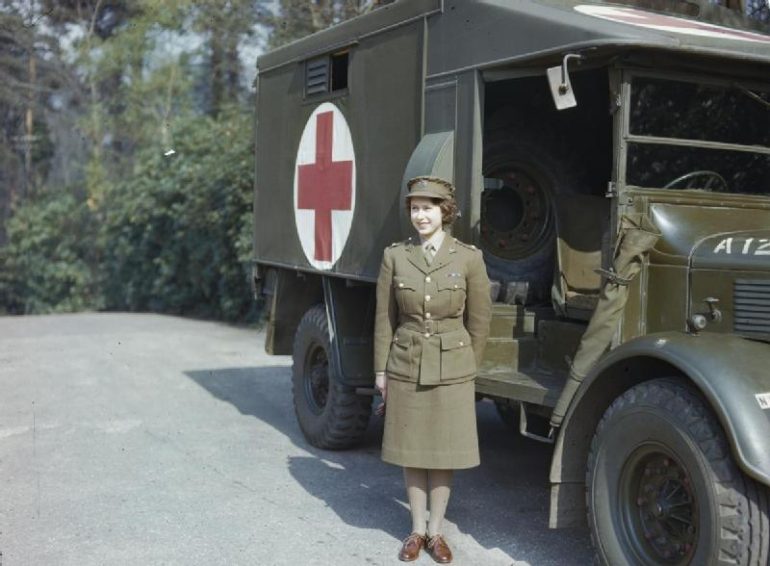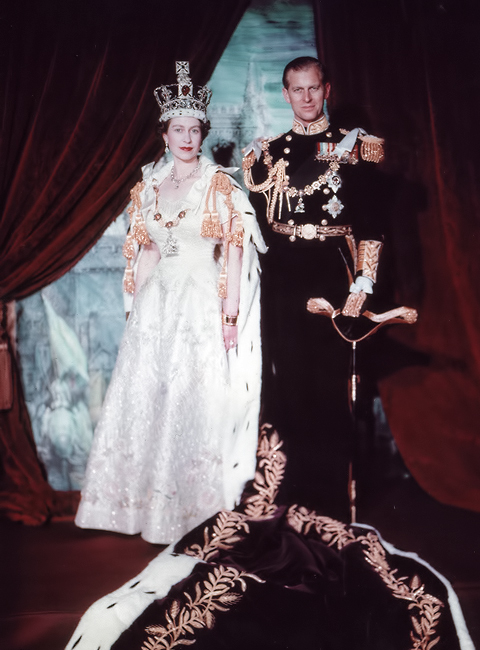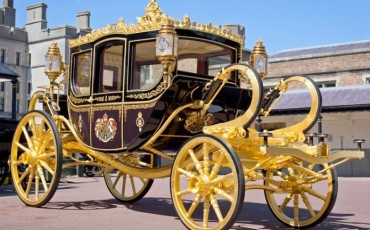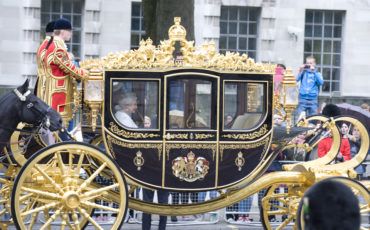Queen Elizabeth II is head of state of the United Kingdom and fifteen other countries. She is also a woman, a mother and was once a girl. Yet throughout her life all of that has come second to providing the symbolic value millions of people placed upon her.
The young Princess Elizabeth was portrayed as the perfect daughter in a normal family, all living together in a normal house, 145 Piccadilly (where the Park Lane Intercontinental Hotel now stands) albeit one that had a ballroom, twenty-five bedrooms, an electric lift and a Boy Scout who operated the telephone.
Her governess recorded that at times she seemed a little too perfect. Shoes were aligned parallel to the bed before going to sleep, treats were graded according to size. It seems accounts of her exemplary behaviour were not just sugar-coating but true. However, she and her sister Margaret often fought, Elizabeth having the more explosive temper.
 British Monarchy: Princess Elizabeth aged seven, painted by Philip de László, 1933. Photo Credit: © Public Domain via Wikimedia Commons.
British Monarchy: Princess Elizabeth aged seven, painted by Philip de László, 1933. Photo Credit: © Public Domain via Wikimedia Commons.
Attempts to increase the rigour of her early education were dismissed by her mother who took the view that neither she nor her sisters had had any great education and: “We all married well, one of us very well”. Neither parent was intellectual and the choice of governess was based as much as anything on her aptitude for walking and love of the outdoors. This all left the Princess Elizabeth with a lingering feeling of intellectual inferiority who would later mistake the name Dante for a horse. Her father was proud of his daughter’s lack of sophistication and found this lack of polish endearing.
Princess Elizabeth’s parents, however, were not completely innocent, had been to parties with the Prince of Wales and had met his mistresses. They were holding back a great tide of change with an oasis of innocence, one that left them unprepared for the Abdication, a crisis brought about by Edward the Eighth’s rejection of middle-class values.
After his accession to the throne and the advent of war George the Sixth thickened the aspic preserving his perfect family. It was the only respite he had from the burdens of kingship. Yet the Princess Elizabeth was growing up. As heir presumptive she was made a Counsellor of State on her eighteenth birthday. In her father’s absence she had to sign the reprieve of a murderer. Elizabeth was increasingly aware of how far removed she was from the real world and how little she knew about it.
The Princess was also desperate to do her bit for the war effort. The chance came just before her nineteenth birthday in early 1945 when she was allowed to join the Auxiliary Territorial Service. Even then she was chaperoned to classes and seated away from the other young women. Members of the class record how she turned around and looked at everyone when they spoke to be able to see and hear as much of them as she could.
 British Monarchy: Princess Elizabeth in Auxiliary Territorial Service uniform, April 1945. Photo Credit: © Public Domain via Wikimedia Commons.
British Monarchy: Princess Elizabeth in Auxiliary Territorial Service uniform, April 1945. Photo Credit: © Public Domain via Wikimedia Commons.
This slow but steady desire to break out perhaps explains her unshakeable decision to marry her third cousin Prince Philip. She fell for him the moment she saw him on a visit to a naval college with her parents. At thirteen she was dressed identically to her younger sister Margaret, four years her junior, while he was already a man of the world.
Within the limited world in which the princess lived, he was as different as could be. As a great-grandson of Queen Victoria, a nephew of the King of Greece and the Queen of Sweden he was born royal so did not treat her with the fawning deference of others around her. Yet he had grown up in penniless exile so had an independence she may never have encountered before. He was also very good-looking. After the War rumours of the romance spread. By 1946 the public started to shout “Where’s Philip?” when Princess Elizabeth appeared in public.
Following marriage Elizabeth was entranced by her firstborn Prince Charles but also besotted with her husband. Like many women of her class in the 1940s, she saw little of her children when they were young. Just before his first birthday in November 1949 she flew out to Malta to join her husband on a naval posting, returning after Christmas before going back out for six weeks in the spring. In Malta, she was briefly able to live the life of a naval wife while she also had a ‘career’ as heir presumptive. She also had a destiny which no-one else had and this was her chance to break away and see the outside world.
 British Monarchy: Coronation portrait of Queen Elizabeth II and Prince Philip, June 1953. Photo Credit: Photo Credit: © Public Domain via Wikimedia Commons.
British Monarchy: Coronation portrait of Queen Elizabeth II and Prince Philip, June 1953. Photo Credit: Photo Credit: © Public Domain via Wikimedia Commons.







Leave a Reply